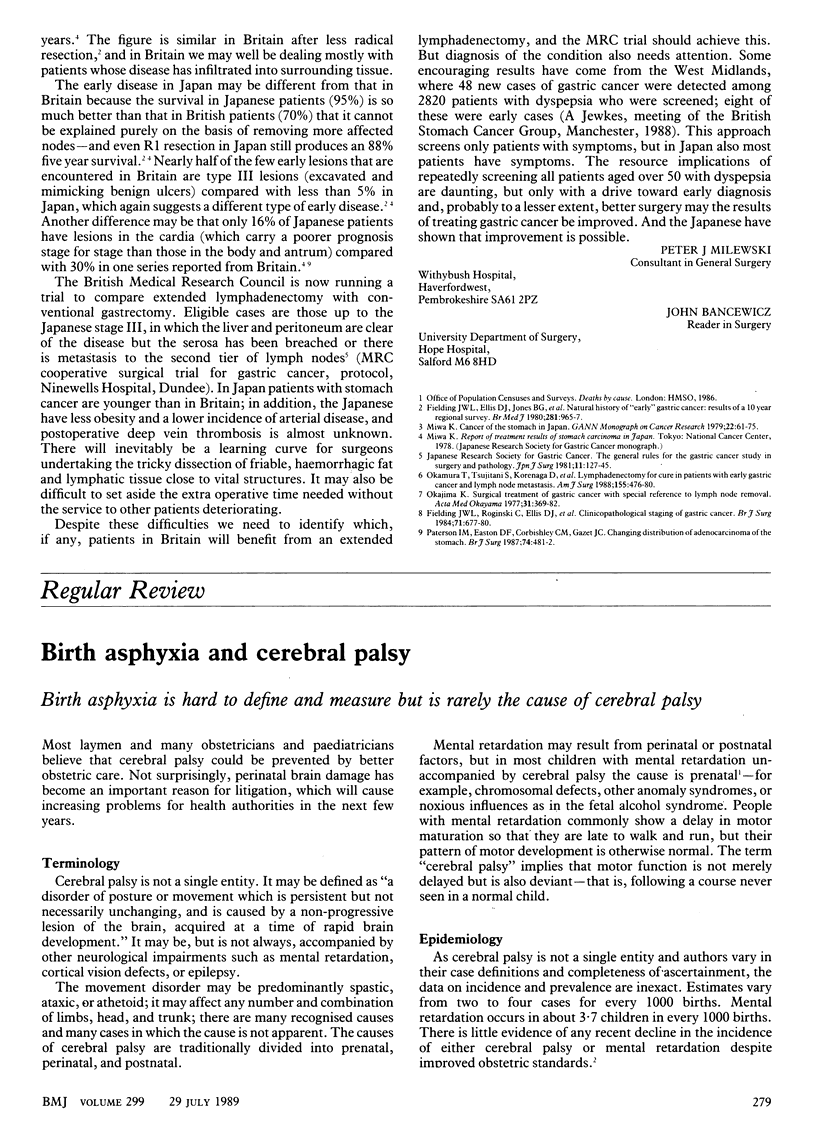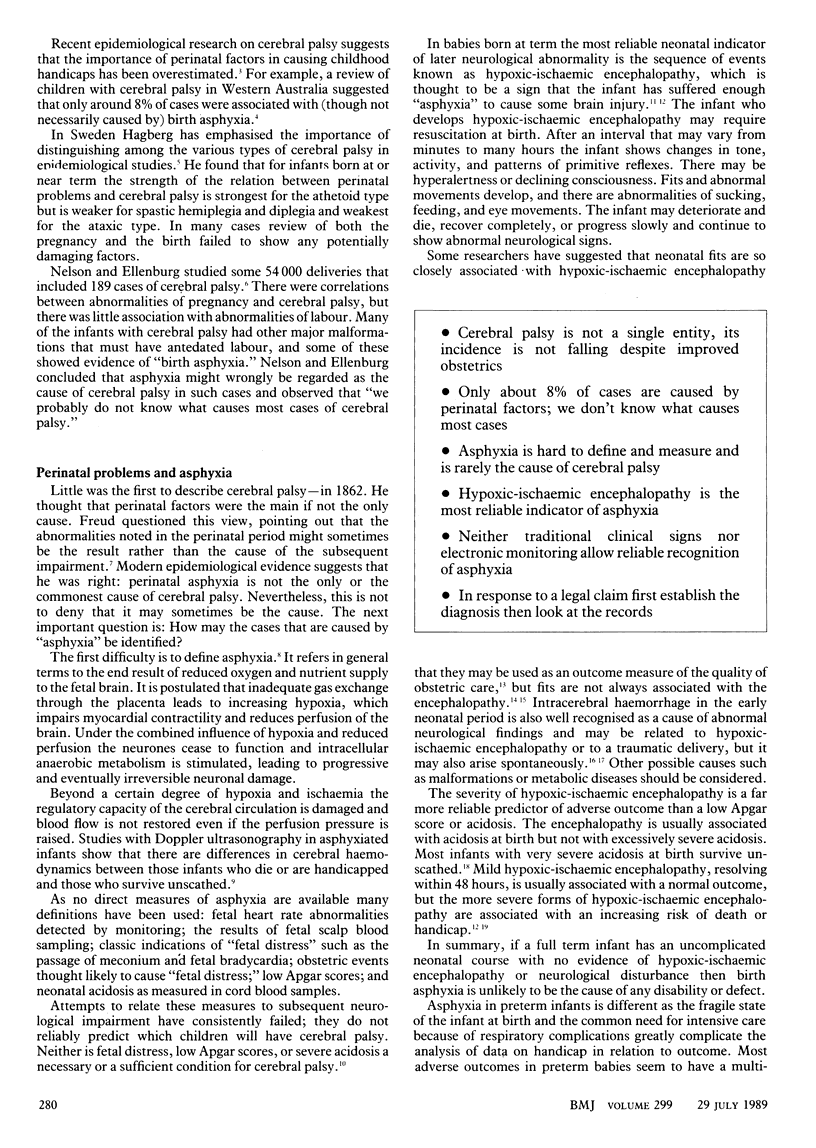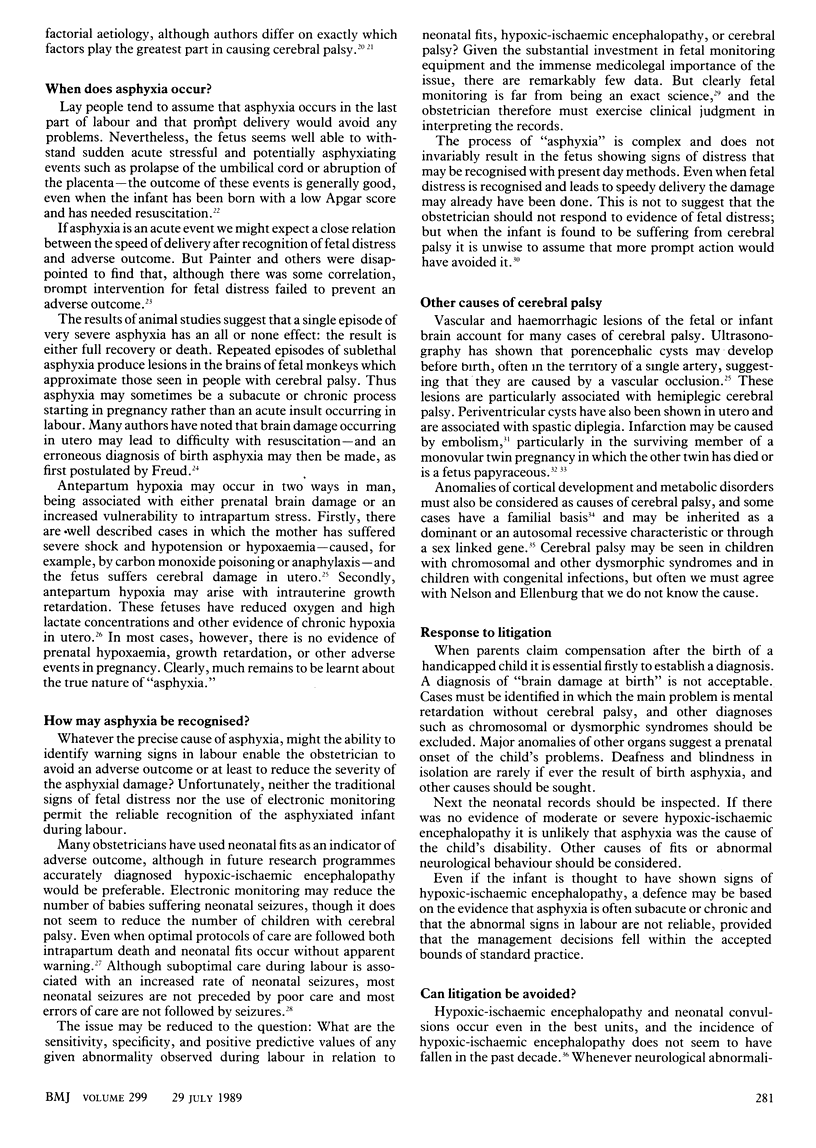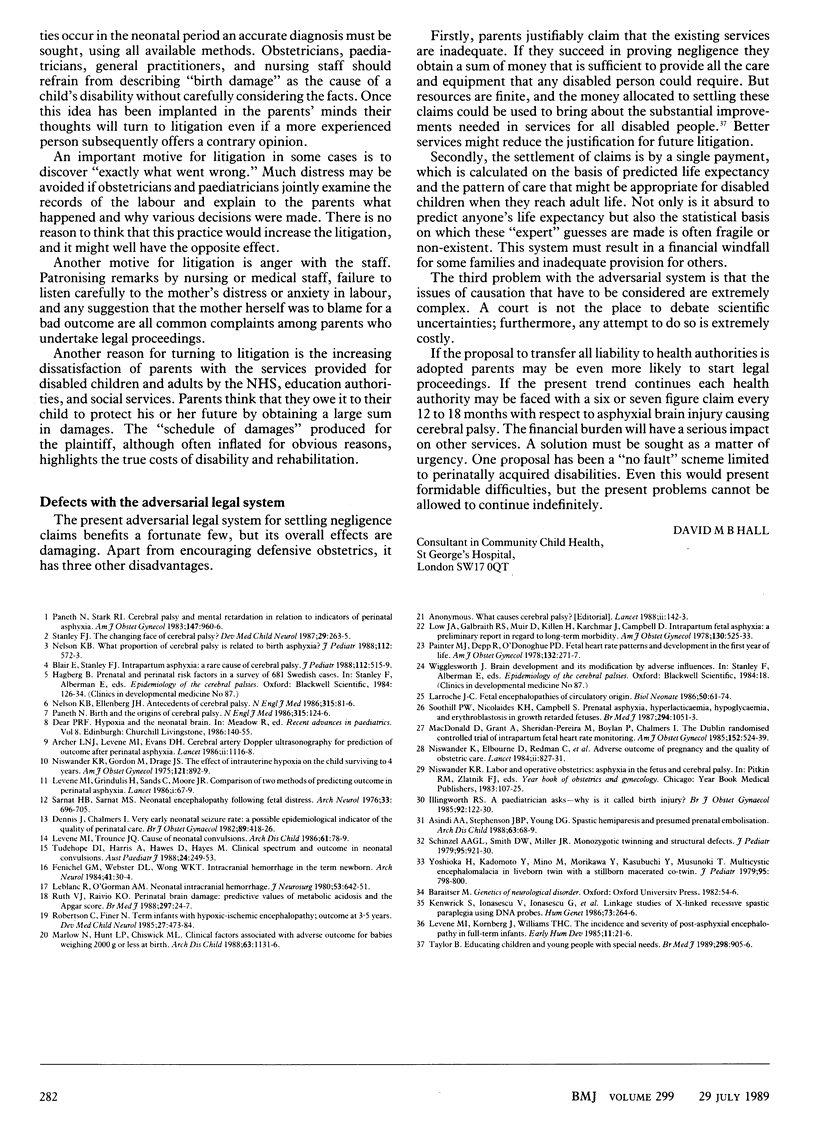Full text
PDF



Selected References
These references are in PubMed. This may not be the complete list of references from this article.
- Archer L. N., Levene M. I., Evans D. H. Cerebral artery Doppler ultrasonography for prediction of outcome after perinatal asphyxia. Lancet. 1986 Nov 15;2(8516):1116–1118. doi: 10.1016/s0140-6736(86)90528-3. [DOI] [PubMed] [Google Scholar]
- Asindi A. A., Stephenson J. B., Young D. G. Spastic hemiparesis and presumed prenatal embolisation. Arch Dis Child. 1988 Jan;63(1):68–69. doi: 10.1136/adc.63.1.68. [DOI] [PMC free article] [PubMed] [Google Scholar]
- Blair E., Stanley F. J. Intrapartum asphyxia: a rare cause of cerebral palsy. J Pediatr. 1988 Apr;112(4):515–519. doi: 10.1016/s0022-3476(88)80161-6. [DOI] [PubMed] [Google Scholar]
- Dennis J., Chalmers I. Very early neonatal seizure rate: a possible epidemiological indicator of the quality of perinatal care. Br J Obstet Gynaecol. 1982 Jun;89(6):418–426. doi: 10.1111/j.1471-0528.1982.tb03630.x. [DOI] [PubMed] [Google Scholar]
- Fenichel G. M., Webster D. L., Wong W. K. Intracranial hemorrhage in the term newborn. Arch Neurol. 1984 Jan;41(1):30–34. doi: 10.1001/archneur.1984.04050130036018. [DOI] [PubMed] [Google Scholar]
- Illingworth R. S. A paediatrician asks--why is it called birth injury? Br J Obstet Gynaecol. 1985 Feb;92(2):122–130. doi: 10.1111/j.1471-0528.1985.tb01063.x. [DOI] [PubMed] [Google Scholar]
- Kenwrick S., Ionasescu V., Ionasescu G., Searby C., King A., Dubowitz M., Davies K. E. Linkage studies of X-linked recessive spastic paraplegia using DNA probes. Hum Genet. 1986 Jul;73(3):264–266. doi: 10.1007/BF00401241. [DOI] [PubMed] [Google Scholar]
- Larroche J. C. Fetal encephalopathies of circulatory origin. Biol Neonate. 1986;50(2):61–74. doi: 10.1159/000242570. [DOI] [PubMed] [Google Scholar]
- Leblanc R., O'Gorman A. M. Neonatal intracranial hemorrhage. A clinical and serial computerized tomographic study. J Neurosurg. 1980 Nov;53(5):642–651. doi: 10.3171/jns.1980.53.5.0642. [DOI] [PubMed] [Google Scholar]
- Levene M. I., Sands C., Grindulis H., Moore J. R. Comparison of two methods of predicting outcome in perinatal asphyxia. Lancet. 1986 Jan 11;1(8472):67–69. doi: 10.1016/s0140-6736(86)90718-x. [DOI] [PubMed] [Google Scholar]
- Levene M. I., Trounce J. Q. Cause of neonatal convulsions. Towards more precise diagnosis. Arch Dis Child. 1986 Jan;61(1):78–79. doi: 10.1136/adc.61.1.78. [DOI] [PMC free article] [PubMed] [Google Scholar]
- Levene M. L., Kornberg J., Williams T. H. The incidence and severity of post-asphyxial encephalopathy in full-term infants. Early Hum Dev. 1985 May;11(1):21–26. doi: 10.1016/0378-3782(85)90115-x. [DOI] [PubMed] [Google Scholar]
- Low J. A., Galbraith R. S., Muir D., Killen H., Karchmar J., Campbell D. Intrapartum fetal asphyxia: a preliminary report in regard to long-term morbidity. Am J Obstet Gynecol. 1978 Mar 1;130(5):525–533. doi: 10.1016/0002-9378(78)90071-6. [DOI] [PubMed] [Google Scholar]
- MacDonald D., Grant A., Sheridan-Pereira M., Boylan P., Chalmers I. The Dublin randomized controlled trial of intrapartum fetal heart rate monitoring. Am J Obstet Gynecol. 1985 Jul 1;152(5):524–539. doi: 10.1016/0002-9378(85)90619-2. [DOI] [PubMed] [Google Scholar]
- Marlow N., Hunt L. P., Chiswick M. L. Clinical factors associated with adverse outcome for babies weighing 2000 g or less at birth. Arch Dis Child. 1988 Oct;63(10 Spec No):1131–1136. doi: 10.1136/adc.63.10_spec_no.1131. [DOI] [PMC free article] [PubMed] [Google Scholar]
- Nelson K. B., Ellenberg J. H. Antecedents of cerebral palsy. Multivariate analysis of risk. N Engl J Med. 1986 Jul 10;315(2):81–86. doi: 10.1056/NEJM198607103150202. [DOI] [PubMed] [Google Scholar]
- Niswander K. R., Gordon M., Drage J. S. The effect of intrauterine hypoxia on the child surviving to 4 years. Am J Obstet Gynecol. 1975 Apr 1;121(7):892–899. doi: 10.1016/0002-9378(75)90906-0. [DOI] [PubMed] [Google Scholar]
- Niswander K., Henson G., Elbourne D., Chalmers I., Redman C., Macfarlane A., Tizard P. Adverse outcome of pregnancy and the quality of obstetric care. Lancet. 1984 Oct 13;2(8407):827–831. doi: 10.1016/s0140-6736(84)90871-7. [DOI] [PubMed] [Google Scholar]
- Painter M. J., Depp R., O'Donoghue P. D. Fetal heart rate patterns and development in the first year of life. Am J Obstet Gynecol. 1978 Oct 1;132(3):271–277. doi: 10.1016/0002-9378(78)90892-x. [DOI] [PubMed] [Google Scholar]
- Paneth N. Birth and the origins of cerebral palsy. N Engl J Med. 1986 Jul 10;315(2):124–126. doi: 10.1056/NEJM198607103150209. [DOI] [PubMed] [Google Scholar]
- Paneth N., Stark R. I. Cerebral palsy and mental retardation in relation to indicators of perinatal asphyxia. An epidemiologic overview. Am J Obstet Gynecol. 1983 Dec 15;147(8):960–966. doi: 10.1016/0002-9378(83)90254-5. [DOI] [PubMed] [Google Scholar]
- Robertson C., Finer N. Term infants with hypoxic-ischemic encephalopathy: outcome at 3.5 years. Dev Med Child Neurol. 1985 Aug;27(4):473–484. doi: 10.1111/j.1469-8749.1985.tb04571.x. [DOI] [PubMed] [Google Scholar]
- Ruth V. J., Raivio K. O. Perinatal brain damage: predictive value of metabolic acidosis and the Apgar score. BMJ. 1988 Jul 2;297(6640):24–27. doi: 10.1136/bmj.297.6640.24. [DOI] [PMC free article] [PubMed] [Google Scholar]
- Sarnat H. B., Sarnat M. S. Neonatal encephalopathy following fetal distress. A clinical and electroencephalographic study. Arch Neurol. 1976 Oct;33(10):696–705. doi: 10.1001/archneur.1976.00500100030012. [DOI] [PubMed] [Google Scholar]
- Soothill P. W., Nicolaides K. H., Campbell S. Prenatal asphyxia, hyperlacticaemia, hypoglycaemia, and erythroblastosis in growth retarded fetuses. Br Med J (Clin Res Ed) 1987 Apr 25;294(6579):1051–1053. doi: 10.1136/bmj.294.6579.1051. [DOI] [PMC free article] [PubMed] [Google Scholar]
- Stanley F. J. The changing face of cerebral palsy? Dev Med Child Neurol. 1987 Apr;29(2):263–265. [PubMed] [Google Scholar]
- Taylor B. Educating children and young people with special needs. BMJ. 1989 Apr 8;298(6678):905–906. doi: 10.1136/bmj.298.6678.905. [DOI] [PMC free article] [PubMed] [Google Scholar]
- Tudehope D. I., Harris A., Hawes D., Hayes M. Clinical spectrum and outcome of neonatal convulsions. Aust Paediatr J. 1988 Aug;24(4):249–253. doi: 10.1111/j.1440-1754.1988.tb01351.x. [DOI] [PubMed] [Google Scholar]
- Yoshioka H., Kadomoto Y., Mino M., Morikawa Y., Kasubuchi Y., Kusunoki T. Multicystic encephalomalacia in liveborn twin with a stillborn macerated co-twin. J Pediatr. 1979 Nov;95(5 Pt 1):798–800. doi: 10.1016/s0022-3476(79)80739-8. [DOI] [PubMed] [Google Scholar]


